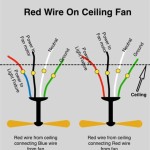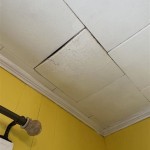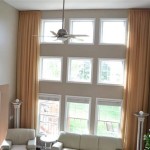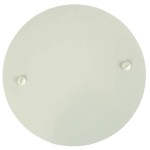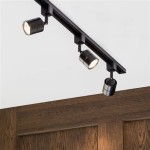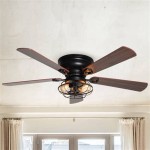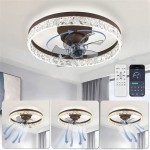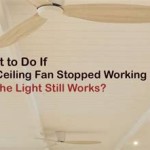Understanding the 120V 60W Ceiling Fan Bulb: A Comprehensive Guide
The 120V 60W ceiling fan bulb is a common lighting component found in many residential and commercial settings. Its purpose is to provide illumination in conjunction with the airflow provided by the fan blades. Understanding the specifications, applications, and variations of this type of bulb is crucial for effective maintenance, replacement, and optimization of ceiling fan performance.
This article aims to provide a comprehensive overview of the 120V 60W ceiling fan bulb, covering its technical details, different types available, factors to consider when choosing a replacement, and troubleshooting common issues. It is intended to provide clear, informative details for those seeking to better understand this essential part of ceiling fan functionality.
Key Features and Specifications
The designation "120V 60W" provides fundamental information about the bulb's electrical characteristics. The "120V" indicates the voltage required for the bulb to operate correctly. In North America and some other regions, 120 volts is the standard household voltage. Using a bulb with a voltage rating lower than the supply voltage can result in premature failure, damage, or even a fire hazard. Conversely, using a bulb with a voltage rating significantly higher than the supply voltage will result in dim or no illumination.
The "60W" signifies the power consumption of the bulb in watts. This value indicates the rate at which the bulb consumes electrical energy when illuminated. A 60W bulb will draw 60 watts of power from the electrical circuit. Higher wattage bulbs consume more electricity and typically produce more light, while lower wattage bulbs consume less electricity and produce less light. Selecting the appropriate wattage is crucial for energy efficiency and to prevent overloading the ceiling fan's electrical circuit.
Ceiling fan bulbs are often designed with a specific base type to ensure compatibility with the fan's light fixture. Common base types include E26 (also known as a medium base, standard incandescent base, or Edison screw base), E12 (candelabra base), and B15 (bayonet base). The base type must match the socket in the ceiling fan's light fixture for the bulb to be properly installed and function correctly. The shape of the bulb also varies, with A15, A19, and globe-shaped bulbs being commonly used in ceiling fans. The size and shape should be compatible with the light fixture housing to ensure proper fit and light distribution.
The light output of a 120V 60W bulb is typically measured in lumens. Lumens represent the total amount of visible light emitted by the bulb. A traditional 60W incandescent bulb typically produces around 800 lumens. However, various factors, such as the bulb's design and technology, can influence the actual lumen output. Color temperature, measured in Kelvin (K), describes the color of the light emitted by the bulb, ranging from warm (yellowish) to cool (bluish). Typical color temperatures for residential lighting range from 2700K (warm white) to 5000K (daylight). The choice of color temperature depends on the desired ambiance and application.
Types of 120V 60W Ceiling Fan Bulbs
While the 120V 60W specification is common, the technology used to produce the light can vary significantly, leading to different types of bulbs with varying energy efficiency, lifespan, and light quality.
Incandescent Bulbs: These are the traditional type of light bulb. They produce light by heating a filament until it glows. Incandescent bulbs are relatively inexpensive to purchase, but they are highly inefficient, converting only a small percentage of the electricity they consume into light. The majority of the energy is released as heat. They also have a relatively short lifespan compared to other types of bulbs. Due to their inefficiency, incandescent bulbs are being phased out in many countries.
Halogen Bulbs: Halogen bulbs are a type of incandescent bulb that uses a halogen gas to improve efficiency and lifespan. They are more efficient than standard incandescent bulbs but still less efficient than more modern technologies like CFLs and LEDs. They produce a bright, white light and have a longer lifespan than traditional incandescent bulbs but generate significant heat.
Compact Fluorescent Lamps (CFLs): CFLs are a type of fluorescent lamp that is designed to be a more energy-efficient replacement for incandescent bulbs. They produce light by passing an electric current through a gas containing mercury vapor. CFLs consume significantly less energy than incandescent bulbs and have a longer lifespan. However, they contain mercury, which requires special disposal procedures, and they may take some time to reach full brightness.
Light Emitting Diodes (LEDs): LEDs are semiconductor devices that emit light when an electric current passes through them. LEDs are the most energy-efficient and long-lasting type of light bulb currently available. They consume significantly less energy than incandescent, halogen, and CFL bulbs, and they have a lifespan that can be several times longer. LEDs are available in a variety of colors and color temperatures, and they turn on instantly without flickering. While initially more expensive than other types of bulbs, the long lifespan and energy savings of LEDs typically result in lower overall cost over their lifetime. LED bulbs designed for ceiling fans are often specifically rated for enclosed fixtures, which is important because heat buildup can shorten their lifespan. Some are also designed to be dimmable, allowing for adjustable light levels.
Factors to Consider When Choosing a Replacement
Selecting the appropriate replacement for a 120V 60W ceiling fan bulb involves considering several factors to ensure compatibility, performance, and energy efficiency.
Compatibility: The first and most crucial factor is compatibility. The replacement bulb must have the correct base type to fit the ceiling fan's light fixture socket. Verify the base type (E26, E12, or B15) by examining the old bulb or the fixture itself. The bulb shape and size must also be compatible with the light fixture housing. Ensure that the replacement bulb fits properly within the housing without obstructing the fan blades or other components.
Brightness and Color Temperature: Determine the desired brightness level for the room. While the original bulb was 60W, a direct replacement with a different technology, such as an LED, may require adjusting the wattage to achieve the same brightness. Consult a lumens-to-watts conversion chart to find an LED bulb with an equivalent lumen output to the original 60W bulb. Consider the color temperature of the light. Warmer color temperatures (2700K-3000K) create a cozy and inviting atmosphere, while cooler color temperatures (4000K-5000K) provide a brighter and more energizing light.
Energy Efficiency and Lifespan: Opt for energy-efficient bulbs such as LEDs to reduce energy consumption and lower electricity bills. LEDs offer significantly longer lifespan compared to incandescent and halogen bulbs, reducing the frequency of replacements. Consider the rated lifespan of the bulb, which indicates the estimated time it will last under normal operating conditions. Look for bulbs with ENERGY STAR certification, which indicates that they meet specific energy efficiency and performance standards.
Dimmability: If the ceiling fan has a dimmer switch, ensure that the replacement bulb is dimmable and compatible with the dimmer switch. Not all LED bulbs are dimmable, and using a non-dimmable bulb with a dimmer switch can cause flickering or premature failure. Check the bulb's packaging or product specifications to confirm its dimming capability. Compatibility charts from the dimmer manufacturer are also helpful.
Safety: When handling light bulbs, especially incandescent and halogen bulbs, allow them to cool down completely before touching them to avoid burns. When replacing a bulb, turn off the power to the ceiling fan at the circuit breaker to prevent electric shock. Dispose of used CFL bulbs properly according to local regulations due to their mercury content. LED bulbs are generally safer to handle and dispose of because they do not contain mercury.
Enclosed Fixtures: Some ceiling fans have enclosed light fixtures, which can trap heat and shorten the lifespan of certain types of bulbs. When selecting a replacement bulb for an enclosed fixture, choose a bulb that is specifically rated for use in enclosed fixtures. LED bulbs designed for enclosed fixtures are often designed with better heat dissipation to prevent overheating and premature failure.
Troubleshooting Common Issues
Several issues can arise with 120V 60W ceiling fan bulbs, requiring troubleshooting and potential replacement.
Bulb Not Lighting: If the bulb is not lighting, first ensure that the ceiling fan is receiving power by checking the circuit breaker. Verify that the bulb is properly screwed into the socket and that the socket contacts are clean and making good contact with the bulb's base. If the bulb still does not light, try replacing it with a new bulb. If the new bulb also fails to light, there may be an issue with the ceiling fan's wiring, switch, or light fixture, requiring professional assistance.
Flickering: Flickering can be caused by several factors. If the bulb is a CFL or LED, it may be incompatible with the dimmer switch, or the dimmer switch may be faulty. Try replacing the bulb with a compatible dimmable bulb or bypassing the dimmer switch to see if the flickering stops. Loose wiring connections in the ceiling fan or the electrical circuit can also cause flickering. Inspect the wiring connections for any loose or corroded wires and tighten or replace them as necessary. Voltage fluctuations in the electrical supply can also cause flickering. If voltage fluctuations are suspected, consult an electrician to assess the electrical system.
Short Lifespan: A bulb that burns out frequently may be due to several factors. Overheating can shorten the lifespan of bulbs, especially in enclosed fixtures. Ensure that the bulb is rated for use in enclosed fixtures and that the fixture has adequate ventilation. Voltage surges can also damage bulbs and shorten their lifespan. Consider using a surge protector to protect the ceiling fan and its light bulbs from voltage surges. Excessive vibration from the ceiling fan can also cause bulb filaments to break prematurely. Ensure that the ceiling fan blades are properly balanced and that the fan is securely mounted to the ceiling.
Dim Light Output: If the bulb is producing dim light, it may be nearing the end of its lifespan. The light output of some bulbs decreases over time. Try replacing the bulb with a new one. Voltage drops in the electrical circuit can also cause dim light output. Consult an electrician to assess the electrical system for any voltage drops.
Buzzing or Humming Noise: CFL and LED bulbs can sometimes produce a buzzing or humming noise, especially when used with a dimmer switch. This noise is usually caused by the interaction between the bulb and the dimmer switch. Try replacing the bulb with a different brand or model of bulb, or replace the dimmer switch with one that is compatible with CFL or LED bulbs. Loose wiring connections can also cause a buzzing noise. Inspect the wiring connections for any loose wires and tighten them as necessary.

Shinestar 3 Pack Ceiling Fan Light Bulbs Small Base 120v 60w Equivalent E12 L Ebay

Feit Electric 60w Equivalent A15 Candelabra Dimmable Cec White Glass Led Ceiling Fan Light Bulb In Bright 3000k 2 Pack Bpa1560c 930ca

Yansun 60 Watt Equivalent Ceiling Fan Light Bulbs 6w C11 Non Dimmable Candelabra Bulb E12 Led In Daylight 12 Pack H Lslz10103e12 The Home

8 Pack E12 Led Ceiling Fan Light Bulbs 120v 60w Eqv Daylight 5000k A15 Candebal Ebay

Shinestar 3 Pack Ceiling Fan Light Bulbs Small Base 120v 60w Equivalent E12 L Ebay

Sylvania Double Life Light Bulbs Ceiling Fan A15 Clear 60 Watts Batteries Lighting D Agostino

Feit Electric 60w Equivalent A15 Candelabra Dimmable Cec White Glass Led Ceiling Fan Light Bulb In Bright 3000k 2 Pack Bpa1560c 930ca

8 Pack E12 Led Ceiling Fan Light Bulbs 120v 60w Eqv Daylight 5000k A15 Candebal Ebay

3 Pack A15 Ceiling Fan Light Bulbs 60w 5000k Daylight Led E12 Candelabra Small Base Non Dimmable

Sylvania 60 Watt Ceiling Fan Light Bulbs Batteries Lighting Martins Emerald

